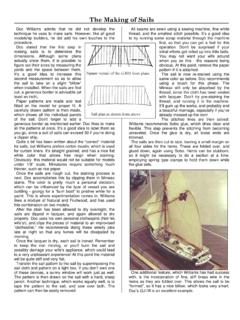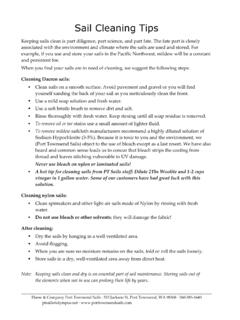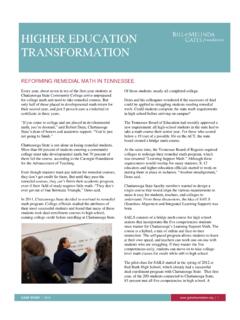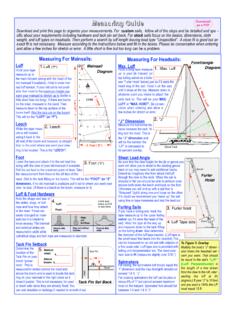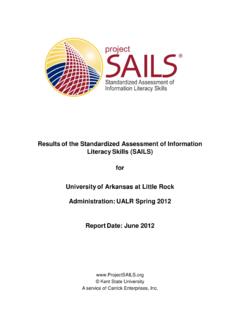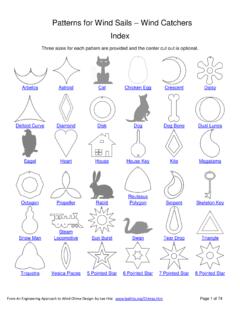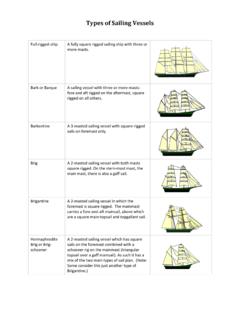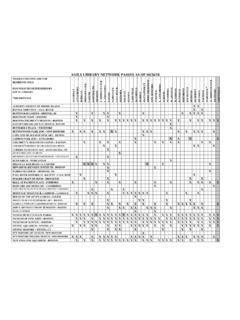Transcription of The Physics of Sailing - University of Colorado Boulder
1 The Physics of SailingRyan M. WilsonJILA and Department of Physics , University of Colorado , Boulder , Colorado 80309-0440, USA(Dated: February 7, 2010)We present a review of the physical phenomena that govern the motion of a Sailing yacht. Motionis determined by force, and the forces on a Sailing yacht depend on the interactions of the hull andkeel of the yacht with the water and on the interactions of the sail or sails of the yacht with theair. We discuss these interactions from the perspective of fluid dynamics, governed ultimately bythe Navier-Stokes equation, and show how forces such as lift and drag are achieved by the relativemotion of a viscous fluid around a body.
2 Additionally, we discuss phenomena that are exclusive tosailing yacht INTRODUCTIONIn the year 1851, about a half century prior to thefirst successful flight of a fixed-winged aircraft, the NewYork Yacht Club s schooner yacht won the Royal YachtSquadron Cup from the Royal Yacht Squadron (a Britishyacht club), and it was thereafter known as the America sCup. This began a series of matches between the holderof the Cup and a challenger (or challengers) that todayare known as the America s Cup Sailing regattas. In-terestingly, the New York Yacht Club held the cup for132 years after it s first victory until, in 1983, the RoyalPerth Yacht Club challenged and won the Cup with theirAustralia IIyacht.
3 About 120 years after the first Amer-ica s Cup regatta, advances in scientific knowledge haddramatically altered the world s understanding of wingedcraft; however, particular attention had been paid to air-craft while Sailing craft had been left much less an afternoon of recreational Sailing with a friend,scientist and Boeing engineer Arvel Gentry fell for thesport and decided to apply his knowledge of aerodynam-ics and fluid mechanics to Sailing yachts in an effort tobetter understand the physical principles that were atwork on them. To his surprise, much of what he read inthe existing literature on the subject was at least mislead-ing, if not completely wrong.
4 His first attempt to rectifythe understanding of the interactions of a sailboat withthe wind and water [1] was ill-received by many, but notall. Indeed, scientist and avid sailor John Letcher tooknotice of Gentry s work and began his own line of re-search involving the application of computational fluiddynamics (CFD) to Sailing yachts, leading to the first ve-locity prediction programs (VPPs), which applied CFDto actual boat geometries and predicted their motion,or velocity, through the water. Later on, Letcher be-came the head scientist on Dennis Conner s team (of theSan Diego Yacht Club) for theStars & Stripes 87yacht,which took the America s Cup back from the Australiansin 1987 [2].
5 Today, the 33rdAmerica s Cup regatta is just aroundthe corner, to be held in the Mediterranean Sea off thecoast of Valencia, Spain in February, 2010. The regattawill be a Deed of Gift [3] match between the Soci et eNautique de Gen`eve (defending the Cup with theAl-inghi 5yacht, shown in figure 1a) and the Golden GateYacht Club (challenging the Cup with BMW Oracle Rac-ing sBOR 90yacht, shown in figure 1b). These boatsare direct products of an advanced understanding of thephysics that governs the motion of a sailboat through thewind and water; respectively, the aero and hydrodynam-ics of Sailing work reviews the Physics , consisting mostly offluid mechanics phenomena, that applies to Sailing yachtsand influences the design of modern Sailing vessels, suchas those to be raced in the 33rdAmerica s Cup regatta.
6 Insection II, the forces that act on a Sailing yacht are intro-duced and discussed. In section III, the fluid mechanicsof viscous fluids flowing around fixed bodies is discussedto explain the origins of the forces that are introducedin section II. Section IV discusses contributions to theforces that are specific to yacht designs and are beyondthe generalization of section FORCES ON A Sailing YACHTLong before the invention of the mechanical engine orthe understanding of fluid mechanics, people attachedsails to boats in order to move them across the sails acted like parachutes, catching the wind andmoving the boat in the direction of the wind, therebylimiting the motion of the boat, more or less, to thisdirection [4].
7 While this limited direction of motion iscertainly a drawback of such a design, another setback isthat the boat speed can never exceed the wind speed withsuch a simple sail. Nevertheless, boats must sometimessail downwind, in which case sails that resemble the morearchaic parachute-like sails must be used. These sailsare called spinnakers and, despite the relatively simpleconcept of downwind Sailing , must be engineered with anontrivial knowledge of fluid addition to employing spinnakers for downwind sail-ing, modern Sailing yachts use other types of sails for sail-ing in directions (points of sail) other than , thinner mainsails and jibs can be used to achievea reach, or a point of sail that is at an angle to thewind direction.
8 Such points of sail can be perpendicularto the wind direction or even have a componentagainstthe wind direction. Such Sailing is called windward 2 FIG. 1: (a) The two-hulledAlinghi 5yacht of the Soci et eNautique de Gen`eve ( )(b) The three-hulledBOR 90yacht of BMW Oracle Racing( ) Sailing , and requires a component of force from the windon the sail that is perpendicular to the direction of thewind. This force is called the aerodynamic lift force,~ force on the sail that is in the direction of the windis called the aerodynamic drag force,~D. These forces areshown in the force diagram in Figure 2. The vectorialsum of~Land~Dgives the total aerodynamic force onthe sail(s),~FT=~L+~D.
9 This force can then be brokendown into components parallel to and perpendicular tothe point of sail, the driving force~FRand the heelingforce~FH, , properly designed keels can generate asimilar lift force as they move through the water to en-hance windward Sailing . This lift is called the hydrody-namic side force,~FS. The force on the keel (and thehull) that is parallel to the apparent motion of the wateris called the hydrodynamic drag force,~R. These forcesare shown in the force diagram in Figure 3. Like theaerodynamic forces, the hydrodynamic side force (hydro-dynamic lift) and hydrodynamic drag can be summed togive the total hydrodynamic force on the keel and hull,~RT=~FS+~R.
10 The origins of both the aero and hydro-dynamic lift and drag forces are discussed in section condition for Sailing at a constant velocity is thatthe hydrodynamic and aerodynamic forces balance, or~RT+~FT= 0.!L!D!vA!FT!FH!FR(apparentwindvelocity) m b aFIG. 2: The aerodynamic forces acting on a Sailing yachtas illustrated for a windward point of sail. Here,~Lis theaerodynamic lift on the sail and~Dis the aerodynamic dragon the sail.!vA(apparentwindvelocity)!R!RT!FS m b hFIG. 3: The hydrodynamic forces acting on a Sailing yachtas illustrated for a windward point of sail. Here,~FSis thehydrodynamic side force, or lift and~Ris the hydrodynamicdrag.

